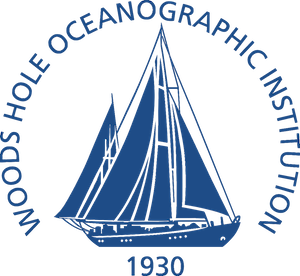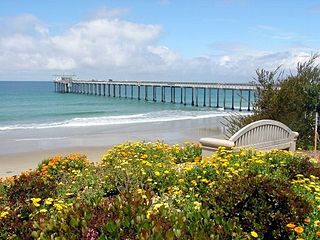Related Research Articles

The Woods Hole Oceanographic Institution is a private, nonprofit research and higher education facility dedicated to the study of marine science and engineering.

The Scripps Institution of Oceanography (SIO) is the center for oceanography and Earth science based at the University of California, San Diego. Its main campus is located in La Jolla, with additional facilities in Point Loma.

The seabed is the bottom of the ocean. All floors of the ocean are known as 'seabeds'.

Alepisaurus ferox, also known as the long snouted lancetfish, longnose lancetfish, or cannibal fish, is a species of lancetfish found in the ocean depths down to 1,830 m (6,000 ft). This species grows to 215 cm (85 in) in total length and a weight of 9 kg (20 lb).

Marine debris, also known as marine litter, is human-created solid material that has deliberately or accidentally been released in seas or the ocean. Floating oceanic debris tends to accumulate at the center of gyres and on coastlines, frequently washing aground, when it is known as beach litter or tidewrack. Deliberate disposal of wastes at sea is called ocean dumping. Naturally occurring debris, such as driftwood and drift seeds, are also present. With the increasing use of plastic, human influence has become an issue as many types of (petrochemical) plastics do not biodegrade quickly, as would natural or organic materials. The largest single type of plastic pollution (~10%) and majority of large plastic in the oceans is discarded and lost nets from the fishing industry. Waterborne plastic poses a serious threat to fish, seabirds, marine reptiles, and marine mammals, as well as to boats and coasts.

The Great Pacific garbage patch is a garbage patch, a gyre of marine debris particles, in the central North Pacific Ocean. It is located roughly from 135°W to 155°W and 35°N to 42°N. The collection of plastic and floating trash originates from the Pacific Rim, including countries in Asia, North America, and South America.

Plastic pellet pollution is a type of marine debris originating from the plastic particles that are universally used to manufacture large-scale plastics. In the context of plastic pollution, these pre-production plastic pellets are commonly known as 'nurdles'. These microplastics are created separately from the user plastics they are melted down to form, and pellet loss can occur during both the manufacturing and transport stages. When released into the open environment, they create persistent pollution both in the oceans and on beaches. About 230,000 tonnes of nurdles are thought to be deposited in the oceans each year, where they are often mistaken for food by seabirds, fish and other wildlife. Due to their small size, they are notoriously difficult to clear up from beaches and elsewhere.

A garbage patch is a gyre of marine debris particles caused by the effects of ocean currents and increasing plastic pollution by human populations. These human-caused collections of plastic and other debris are responsible for ecosystem and environmental problems that affect marine life, contaminate oceans with toxic chemicals, and contribute to greenhouse gas emissions. Once waterborne, marine debris becomes mobile. Flotsam can be blown by the wind, or follow the flow of ocean currents, often ending up in the middle of oceanic gyres where currents are weakest.

Marine plastic pollution is a type of marine pollution by plastics, ranging in size from large original material such as bottles and bags, down to microplastics formed from the fragmentation of plastic material. Marine debris is mainly discarded human rubbish which floats on, or is suspended in the ocean. Eighty percent of marine debris is plastic. Microplastics and nanoplastics result from the breakdown or photodegradation of plastic waste in surface waters, rivers or oceans. Recently, scientists have uncovered nanoplastics in heavy snow, more specifically about 3,000 tons that cover Switzerland yearly.

The North Atlantic garbage patch is a garbage patch of man-made marine debris found floating within the North Atlantic Gyre, originally documented in 1972. A 22-year research study conducted by the Sea Education Association estimates the patch to be hundreds of kilometers across, with a density of more than 200,000 pieces of debris per square kilometer. The garbage originates from human-created waste traveling from rivers into the ocean and mainly consists of microplastics. The garbage patch is a large risk to wildlife through plastic consumption and entanglement.
The 5 Gyres Institute is a 501(c)(3) non-profit organization that focuses on reducing plastics pollution by focusing on primary research. Programs concentrate on science, education and adventure. Since 2017, 5 Gyres has been in special consultative status with the United Nations Economic and Social Council. The organization's 2015 Expedition was featured in the 2017 documentary "Smog of the Sea," produced by Jack Johnson, who participated in the voyage.
Lisa A. Levin is a Distinguished Professor of biological oceanography and marine ecology at the Scripps Institution of Oceanography. She holds the Elizabeth Hamman and Morgan Dene Oliver Chair in Marine Biodiversity and Conservation Science. She studies coastal and deep-sea ecosystems and is a Fellow of the American Association for the Advancement of Science.
Kimberly A. Prather is an American atmospheric chemist. She is a distinguished chair in atmospheric chemistry and a distinguished professor at the Scripps Institution of Oceanography and department of chemistry and biochemistry at UC San Diego. Her work focuses on how humans are influencing the atmosphere and climate. In 2019, she was elected a member of the National Academy of Engineering for technologies that transformed understanding of aerosols and their impacts on air quality, climate, and human health. In 2020, she was elected as a member of the National Academy of Sciences. She is also an elected Fellow of the American Philosophical Society, American Geophysical Union, the American Association for the Advancement of Science, American Philosophical Society, and the American Academy of Arts and Sciences.
Abigail P. W. Barrows is an American marine research scientist and advocate based in Maine. Barrows directs microplastics research that is used to inform conservation-focused legislation, and she initiated the first baseline data map of microplastic pollution distribution in the waters off the coast of Maine.
Tamara Susan Galloway is a British marine scientist and Professor of Ecotoxicology at the University of Exeter. She was appointed an Officer of the Order of the British Empire in the 2019 Birthday Honours.

Chelsea Marina Rochman is an American marine and freshwater ecologist whose research focuses on anthropogenic stressors in freshwater and marine ecosystems. Since September 2016, Rochman has been an assistant professor at the University of Toronto in the department of Ecology and Evolutionary Biology and a scientific advisor to the Ocean Conservancy.
Angelicque E. White is an American oceanographer. She is an associate professor at the University of Hawaiʻi at Mānoa School of Ocean and Earth Science and Technology and director of the Hawaii Ocean Time-series (HOT) program.
Elizabeth Trembath-Reichert is a geomicrobiologist and astrobiologist at Arizona State University's School of Earth and Space Exploration.
Jennifer Ann Mackinnon is an American physical oceanographer who has studied small-scale dynamical processes in oceans for more than 20 years. These processes include internal waves and ocean mixing, turbulence, sub-mesoscale instabilities, and their complex interaction. She is a professor at the Scripps Institution of Oceanography (SIO) of the University of California, San Diego (UCSD). Her research requires extensive fieldwork at sea to observe these processes.
Edem Mahu is a Ghanaian marine scientist who is a senior lecturer at the University of Ghana. Her research considers ocean health, oyster fisheries and climate change. She was awarded the 2022 American Geophysical Union Africa Award for Research Excellence in Ocean Sciences.
References
- ↑ "Choy, Anela". Scripps Institution of Oceanography. 2018-08-15. Retrieved 2019-10-08.
- ↑ Gammon, Katharine (2019-06-06). "'Pieces of human society': deep ocean may be riddled with microplastics". The Guardian. ISSN 0261-3077 . Retrieved 2019-10-08.
- ↑ "Monterey Bay Is a Natural Wonder—Poisoned With Microplastic". Wired. ISSN 1059-1028 . Retrieved 2019-10-08.
- ↑ Zhang, Sarah (2019-06-06). "We Were Missing Most of the Plastic in the Ocean". The Atlantic. Retrieved 2019-10-08.
- ↑ "WSL PURE: Anela Choy Spotlight". World Surf League. Retrieved 2019-10-08.
- ↑ "ICYMI: Lifetime Member Dr. Anela Choy's Research on Microplastic Ocean Pollution Featured Across News Outlets – SACNAS" . Retrieved 2019-10-08.
- ↑ "Anela Choy shares her story | United Nations Educational, Scientific and Cultural Organization". www.unesco.org. Retrieved 2019-10-08.
- ↑ "L'Oréal and UNESCO Honor U.S.-Based Researcher for Scientific Achievements - L'Oréal USA". www.lorealusa.com. Retrieved 2019-10-08.
- ↑ "Four UC San Diego Faculty Members Awarded 2021 Sloan Research Fellowships". ucsdnews.ucsd.edu. Retrieved 2021-06-08.